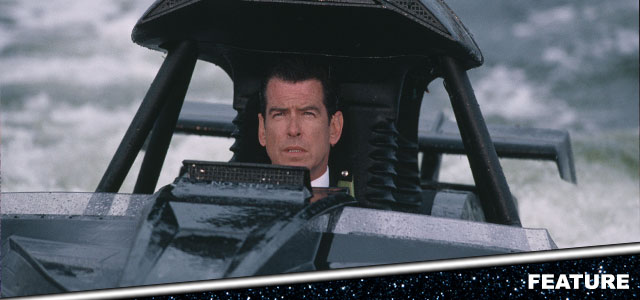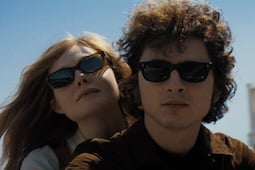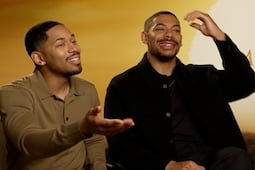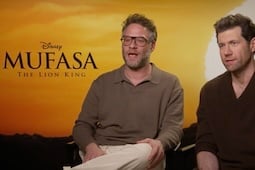
The 25th James Bond movie No Time To Die arrives in Cineworld in September, and we're counting down the days by revisiting all the 007 movies in chronological order of release.
In honour of Daniel Craig's swansong as 007, we're taking a nostalgic trip back through time. This week: Pierce Brosnan stars in The World Is Not Enough.
What is the story of The World Is Not Enough?
When MI6 headquarters in London is bombed, secret agent James Bond/007 (Pierce Brosnan) uncovers a trail of evidence that leads directly to notorious terrorist Renard (Robert Carlyle), who can't feel pain owing to a bullet that's lodged in his head. Bond suspects that Renard has returned to target former kidnap victim Elektra King (Sophie Marceau), wealthy heiress to an oil empire, whose father was killed in the MI6 explosion.
Bond is sent to Baku in Azerbaijan by his superior M (Judi Dench), under orders that he protect Elektra from any potential threat. However, as the two start to fall for one another, Bond suspects the conspiracy is even more complicated, with a mysterious figure looking to target the oil-rich pipelines of the Caspian Sea for their own ends. Working with nuclear scientist Christmas Jones (Denise Richards), 007 uncovers more than a few nasty surprises.
How did The World Is Not Enough get made?
Everyone has their formative James Bond experience, as in the first 007 movie they saw in the cinema. For this writer, it came at the age of 12, with 1999 Pierce Brosnan vehicle The World Is Not Enough. At the time, the movie's utterly frenetic, explosive quality was more than enough to satisfy a pre-teen appetite; on reflection, the movie's storytelling flaws become more apparent, although the attempts to darken Brosnan's Bond portrayal are admirable, if somewhat half-hearted.
Both of Brosnan's previous Bond movies, GoldenEye and Tomorrow Never Dies, had proven to be commercial hits, although only the former attained a measure of critical respect. The films were very much Bond blockbusters for the 1990s generation: slick, glossy and rammed with enough pyrotechnics and gadgets to make Michael Bay blush. Buried in there somewhere was an attempt to give Bond more context and edge – this becomes most apparent in GoldenEye's riffing on a post-Cold War landscape. Ultimately, however, both films were more concerned with forward momentum and action set-pieces.
These issues would continue to blight Brosnan's third movie, The World Is Not Enough, the final Bond movie to be released in the millennium. It was not just a fin de siecle ('end of the century') moment for Bond but a full-on advance into a strange new world that, at the time of the movie's release, was overshadowed by paranoid technological fears. (One of the early proposed titles was 'Bond 2000'.) Such concerns are hardwired into The World Is Not Enough's plot, from the overabundance of hardware to the technological corruption of its oil theft storyline and the electronic beats of David Arnold's score.
As with all the Bond movies, it's very much a product of its time. The question is this: does The World Is Not Enough do anything particularly radical with the Bond formula? There's no denying the attempt to invest the movie with greater credibility, starting with the appointment of director Michael Apted, who sought to do more with the treatment of the female characters. Apted had a great facility with strong women leads in his movies, from Sissy Spacek in Coal Miner's Daughter (for which she won an Oscar) to Sigourney Weaver in Gorillas in the Mist.
Apted was a rare Bond director with a revered critical reputation, and one can sense his attempt to impose more character depth on the storyline, written by the in-house team of Neal Purvis and Robert Wade. Yet, as ever with the Brosnan movies, intelligent ideas are undercut by inane ones, the complex and engrossing portrayal of Sophie Marceau's Elektra undercut by the stunt casting of Denise Richards as nuclear scientist Dr. Christmas Jones. (The character would become one of the most pilloried in the history of the franchise.)
However, one cannot knock Brosnan's confidence in the title role; one suspects he's full on board to explore the emotional and physical frailties of Bond, which manifest in the story in different ways. The World Is Not Enough is unique in the Bond canon in that the thrilling pre-credits sequence ends with 007 sustaining an injury to his collarbone, which is interwoven into the rest of the plot. (Of course, it only rears its head when necessary for the plot.)
More interestingly, this is one of the Bond movies where 007 is actively betrayed by the romantic interest – Elektra is introduced as a vulnerable heiress to an oil empire, but in a well-wrought twist, is revealed to be the one behind all the terrorist machinations. For once, Bond is caused a degree of emotional and psychological anguish, and it's well-acted by Brosnan and Marceau; would that the movie hadn't fallen back on the usual Bondian tropes elsewhere.
Although not based on an Ian Fleming story, The World Is Not Enough takes its title from Bond's family motto that was referenced in 1969's On Her Majesty's Secret Service. The script, by Purvis and Wade, was later punched up by Apted's wife Dana, who sought to add more depth to the women in the story. This is most apparent in the character of Elektra, the first woman in the history of the franchise to flip from apparent protagonist to antagonist. (One could argue this also happened with Eva Green's Vesper Lynd in the later Casino Royale.)
Braveheart star Sophie Marceau does a good job working with Apted on fleshing out Elektra's motivations, killing her father to secure the oil pipeline that she feels is rightly hers. There's also the suggestion of a darker relationship shared between Elektra and the film's nominal villain Renard, played by Robert Carlyle; one of the film's more intelligent moves is to suggest that the all-powerful terrorist is in fact in thrall to the woman he kidnapped, and is essentially the lesser of the two evils in the story. Bond incorrectly assumes at first that Elektra turns evil owing to Stockholm Syndrome, in which a kidnap victim forms a deep-seated bond with their captor; however, it's revealed that Elektra suffered no such thing, and in fact switched Renard to her scheme entirely of her own volition.
The scene where Bond eventually shoots Elektra dead in cold blood is one of Brosnan's most effective Bond scenes, approaching the harder edge of Timothy Dalton's portrayal. As producer Barbara Broccoli explained: "With Elektra, Bond thinks he has found [first wife] Tracy, but he's really found Blofeld". It's a bold storytelling move that in the Dalton or Craig eras would probably have been explored with a degree of depth. As it stands, these scenes are ultimately second-fiddle to the next quip, gadget or explosion. And what explosions they are: although The World Is Not Enough purports to be a grim, somewhat more topical Bond story, it one-ups its predecessors in terms of the noisy action sequences.
Under the assured hand of veteran second unit director Vic Armstrong (who had also worked on all the Indiana Jones movies), The World Is Not Enough hurtles Bond into danger in a variety of locations, both recognisable and exotic. This begins with the utterly spectacular River Thames boat chase during the pre-title sequence; at 15 minutes, it's the longest in the franchise. (The reason was the credits were meant to kick in with Bond's leap from the Bilbao bank, but the filmmakers deemed this underwhelming, so the credits instead began after the boat sequence concluded.)
This is possibly the most inventive and thrilling use of London in the entire series, beginning at the bombed-out MI6 headquarters and ending at the (then new-fangled) Millennium Dome. Bond pursues his quarry, known only as 'Cigar Girl' (Maria Grazia Cucinotta) in a brand new speedboat developed by Q branch, complete with missiles, rocket boosters and a handy dive option. (The sly moment where Bond adjusts his tie underwater was an improv from Brosnan.) Propelled along by David Arnold's score, it's a typically outlandish yet deliriously exciting Bond action sequence that nails the unflappable approach of the character. (Watch out for the two clampers who get splashed by Bond – these guys were the real-life stars of short-lived British TV series Clampers.)
In addition to Bilbao during the opening sequence (the city's famous Guggenheim Museum can be spotted), The World Is Not Enough lensed in Istanbul, which plays an important role during the climactic confrontation with Elektra and Renard. Elektra's island hideout was in fact the famous Maiden's Tower, and the majestic Küçüksu Palace was also used. Britain stood in for several locations: the interior of the Baku casino where Bond meets contact Valentin Zukovsky (Robbie Coltrane) was in fact Halton House in the Chiltern Hills.
The exteriors of the assault on Zukovsky's caviar factory (by helicopters armed with suspended saws, naturally) were captured in the interior water tank at Pinewood Studios, the spiritual home of the 007 franchise. (Both Goldeneye and Tomorrow Never Dies had, however, been denied the opportunity to film there.) And a mixture of Snowdonia and Swindon was used during the oil pipeline explosion scene, during which Bond and Christmas Jones occupy a 'pig' travelling the pipeline and uncover evidence of Elektra's betrayal.
Other substitute locations included Navarre, Spain, which stood in for the exterior of the Kazakhstan nuclear facility that's bombed by Renard. And the slopes of Mount Chamonix in France stood in for the snowy landscapes of the Caucusus during the scene where Bond and Elektra come under attack from aerial 'parahawks'. Of course, it's revealed later on that Elektra was bluffing in this sequence, and she was never the target at all. It's a suitably lush array of locations that does justice to the reputation of the Bond franchise – with a budget of $125 million, the largest in the series so far, this movie could afford to go all-out on locations and hardware.
In addition to the Bond boat, the movie also incorporates the third and final BMW seen in the Brosnan era: the BMW Z8, whose surface-to-air missiles Bond uses during the attack on Zukovsky's caviar factory. (The car's fate immediately after that moment is both hilarious and painful to petrolheads.) After this, following the expiration of the three-movie BMW deal arranged prior to GoldenEye, Bond would return to his trusty Aston Martin In Die Another Day.
If the stunts and gadgets are admirable, then The World Is Not Enough also deserves credit for drawing Judi Dench's M further into the fold. M's guilt over her course of action during Elektra's kidnapping by Renard sets the story in motion – the head of MI6 believed she could use the girl as bait in order to capture the notorious terrorist. When Elektra, later released from captivity, discovers this, she puts her diabolical plan into action, luring M over to Baku and kidnapping her, which puts Bond through the wringer. Although the real-life kidnapping of the head of MI6 would likely cause a global panic, we don't get any sense of this in the movie; nevertheless it's refreshing to see Dench, fresh from her Oscar win for 1998's Shakespeare in Love, at the centre of the story, rather than on the margins.
And if we're talking Bond's allies, then one of his longest-standing makes his final appearance in The World Is Not Enough. This is the movie where Desmond Llewelyn's Q bows out, 36 years after appearing in From Russia With Love as Bond's (then unnamed) Quartermaster. The veteran actor had been the longest-serving member of the Bond crew, outlasting actors, directors, composers and producers, and it's somewhat eerie that his final moment should see Q sink into the floor while standing on a lift. (Shortly after the release of the movie, Llewelyn was killed in a car accident.) Fortunately, he goes out in style with one of Q's best lines: "I've always tried to teach you two things. First never let them see you bleed. And second, always have an escape plan." The Bond movies were never the same after Llewelyn's departure, something that becomes clear in the movie's awkward handover to the far more bumbling R, played by British comedy icon John Cleese.
Yet for all the film's sincerity in its treatment of Elektra and Bond's allies, it lets itself down with the casting of Denise Richards as Christmas Jones. One cannot be sure if the movie is attempting to make a sly in-joke about the franchise's propensity for implausible female characters, or if this is just a flat-out misstep. What can't be denied is that Richards, in her hotpants and tank top, not to mention wooden delivery, is the least plausible nuclear scientist ever conceived. Did the filmmakers get cold feet regarding the grounded portrayal of Elektra, and feel the need to revert to type in order to reset the balance?
It's the kind of issue that taints the Brosnan Bond era, not helped by quips that Roger Moore may have blanched at. ("I thought Christmas only comes once a year," is the final howler during Bond and Christmas's closing love scene.) For all the strengths of The World Is Not Enough, it really did need the courage of its convictions to emerge as a 007 classic; in reality, a sense of gritty and emotional atmosphere would only be fully sustained when Daniel Craig took over the role in Casino Royale.
READ MORE
- No Time To Die and the 6 James Bond movies we never got to see
- 7 actors who could play James Bond after Daniel Craig retires
- Shaken and stirred! Daniel Craig's defining 007 moments
What music is on the soundtrack for The World Is Not Enough?
Like Tomorrow Never Dies, The World Is Not Enough excels with its orchestral/electronic hybrid score. It was the second from composer David Arnold, who became enlisted as the new in-house Bond composer until 2008's Quantum of Solace; Arnold's propensity for symphonic mayhem and rhythmic experimentation made him the ideal replacement for John Barry, who had bowed out with 1987's The Living Daylights.
Whereas Tomorrow Never Dies was a primarily orchestral score, The World Is Not Enough beefs up the synthetic undercurrent, a deliberate move from Arnold who sought to make the music "more contemporary". The score's rollicking, extended set-pieces do a marvellous job of both honouring and updating the traditional Barry sound, with various samples and pads giving an appropriately pre-Millennium, late-90s feel to proceedings. And where one might have expected the music to date, it's actually stood up very well in the last 20 years, precisely because Arnold is loyal to the organic, timeless construct of the symphony orchestra, against which the electronics play a supporting role. (This would trip Arnold up in his far inferior score for Die Another Day.)
Unlike Tomorrow Never Dies, Arnold's opening credits song was allowed to remain in place. 'The World Is Not Enough' is performed by then in-vogue rockers Garbage, and singer Shirley Manson's voice has an arrestingly moody quality that follows in the footsteps of Shirley Bassey. The song is unique in the wider Bond canon in that it's the only one performed from the point of view of the main female character. (Elektra's line "There's no point in living if you can't feel alive" appears at one point.) The lyrics, written by Don Black in his fifth Bond outing, speak of Elektra King's desire to rule the world, which when accompanied by Danny Kleinman's arresting oil slick credit designs, set an appropriately moody and portentous tone.
Arnold, in fact, composed two songs for the movie. The second, 'Only Myself To Blame', was performed by the late Scott Walker and intended for the end credits; however, director Michael Apted favoured a remix of the traditional Bond theme. The melody from Walker's song informs the underscore material for Elektra King's character: moody, supple piano arrangements speak of her inner torment and anguish in stylish tracks like 'Casino' and 'I Never Miss'.
The main melody from 'The World Is Not Enough' is subtly interwoven into many tracks, swirling and captivating with its Barry-esque horn trills and strings. The piece 'Snow Business' (presumably a reference to the track 'Snow Job' from Barry's A View To A Kill score) is a classic case in point, a beautiul, scene-setting bit of music.
However, because the movie is largely dominated by action, Arnold's score is compelled to follow suit. This allows him to break out the mayhem and excitement of Tomorrow Never Dies and earlier hits like Independence Day, putting the orchestral ensemble through the wringer. The sensational opening 'Come In 007, Your Time Is Up', which accompanies the Thames boat chase scene, is just such an example, with its regular horn blasts of The World Is Not Enough Melody and pulsating electronic undercurrent. There's also a fantastic, guitar-laden rendition of the Bond theme, which peaks in intensity when 007 comes in sight of the Millennium Dome.
The other set-pieces are no less impressive. 'Going Down/The Bunker' and 'Pipeline' throw around insistent bursts of percussion and brass before building to cacophonous crescendos of excitement. 'Caviar Factory' perhaps owes the greatest debt to Barry's legacy, with its tongue in cheek, swooping horn arrangements capturing the nature of the armed helicopters in the scene. With his awareness of the Bond heritage and his desire for experimentation, Arnold had proven himself a secret weapon in the Bond arsenal.
How was The World Is Not Enough received?
Against its hefty $125 million budget, The World Is Not Enough grossed $362 million worldwide. This made it the most financially successful movie in the series so far, until the release of its successor Die Another Day in 2002. But was it a case of diminishing returns as far as the Bond character was concerned?
Critics thought so: the reception to The World Is Not Enough was decidedly frosty. The film became the first in the history of the franchise to win a Golden Raspberry, or 'Razzie', which went to Worst Supporting Actress for Denise Richards. (This was offset somewhat by an Oscar nomination for Best Visual Effects.)
Variety's Peter Debruge wrote that "[The World Is Not Enough] presents a conflicted persona torn between the corny antics of the Roger Moore era and the grim seriousness of where things would eventually go under Daniel Craig’s tenure. It also contains a dose of Timothy Dalton-esque toughness [...] Much of what made Brosnan such a great Bond is thrust into the backseat by lame jokes and a premature attempt to mix up the formula."
By contrast, noted reviewer Roger Ebert loved the movie, describing it as "splendid comic thriller, exciting and graceful, endlessly inventive". Even so, it was hard to escape the feeling that even the most positive reviews were of a begrudging kind, critics having to qualify their awareness of the silliness of the Bond formula. Wasn't it time things got shaken up, for the series to land some emotional punches as well as literal ones?
What was the next movie in the James Bond series?
Pierce Brosnan returns as 007 in Die Another Day, released in 2002.
When is No Time To Die released in the UK?
Click here to book your tickets for No Time To Die, which is released on 30th September. Don't forget to tweet us your favourite James Bond movies @Cineworld.














.jpg)
.png)






